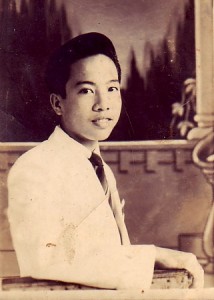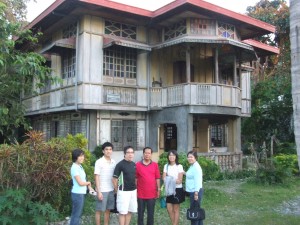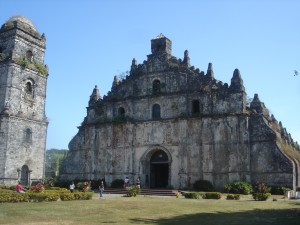From Susan Concepcion Echiverri MD
 My husband is Henry Echiverri MD. His father pictured on the left is CRISPIN POBRE ECHIVERRI, MD. Crispin was born in Paoay October 15, 1923. His father, Gregorio, left the family to be a sugarcane plantation farm laborer in Kauai. Gregorio was there during WW II, the time that my father in law, Crispin, was a teenager and enlisted with the US Army and fought as a guerilla in the mountains of Ilocos Norte and Sur, Abra, Mountain Province and Benguet under Colonel Volksmann. He ran after Yamashita’s troops and to this day remembers where the treasure was buried [4 meters away and deep from the oldest Oak tree in the highest mountain north of Baguio, which is known as Mount Data, the regimental headquarters of the Japanese General]. He was part of the ‘mopping up’, a short teenager, who rode on a horse as a special favor to him by an uncle [Esteban Sadang]. He remembers such niceties, some of them lifesaving, like the malaria pills that were precious and yet bestowed on him as he was convulsing with fever and rigors [from dysentery and malaria]. My father-in-law remembers all the names of his benefactors. He also remembers the darkest dark that were the nights when they trounced in mud, in the rain as they ran after troops to ambush or sometimes, ran away from enemies they could not muster.
My husband is Henry Echiverri MD. His father pictured on the left is CRISPIN POBRE ECHIVERRI, MD. Crispin was born in Paoay October 15, 1923. His father, Gregorio, left the family to be a sugarcane plantation farm laborer in Kauai. Gregorio was there during WW II, the time that my father in law, Crispin, was a teenager and enlisted with the US Army and fought as a guerilla in the mountains of Ilocos Norte and Sur, Abra, Mountain Province and Benguet under Colonel Volksmann. He ran after Yamashita’s troops and to this day remembers where the treasure was buried [4 meters away and deep from the oldest Oak tree in the highest mountain north of Baguio, which is known as Mount Data, the regimental headquarters of the Japanese General]. He was part of the ‘mopping up’, a short teenager, who rode on a horse as a special favor to him by an uncle [Esteban Sadang]. He remembers such niceties, some of them lifesaving, like the malaria pills that were precious and yet bestowed on him as he was convulsing with fever and rigors [from dysentery and malaria]. My father-in-law remembers all the names of his benefactors. He also remembers the darkest dark that were the nights when they trounced in mud, in the rain as they ran after troops to ambush or sometimes, ran away from enemies they could not muster.
He started as Premed in UP but was interrupted by the war. His ROTC unit was activated and was to be sent to Bataan. Unfortunately, first batch was ambushed and the rest of his unit was disbanded when Manila was declared an Open City for the occupation of Japanese Military to save further bloodshed. An aunt [Felicia Echiverri, daughter of Tomas Echiverri] hired a truck from Narvacan and came looking for the young students in Manila to take them home to Ilocos in 1942. At 19 years of age, Crispin worked as an Intelligence operative in Ilocos region, ultimately joining the guerilla fighting unit that covered the northern part of the Philippines. He obtained his MD degree from UST 1952 and became a Malariologist, traveling the country north to south, bringing back exotic pets, garlic or lobster or hand carved wood ornaments. His father Gregorio came home after a long stint in those fields in Hawaii that nobody else in his family ever saw, and he came in time to celebrate the birth of my husband. There is a portrait of infant Henry being cradled by his grandpa [see post on Gregorio]. Soon thereafter, the Hawaii plantation worker would die.
I myself come from a family with roots that may have run just as deep as my husband’s. There is also drama all around, of children being bayoneted by the Japanese,and scandals being followed by bankruptcies. Though I hold dear the textures and colors of my aunt’s retelling of fortunes lost and what could have been, I always favored the images of my father-in-law and his comrades marching into the devil darkness of war. I also found the mountains of the north too mysterious and the traveling imposed on my husband’s youth mesmerizing.
 In 2006, I gathered up my family – 18 and 15 year old daughters, 16 year old son and my husband and went back to my country of birth. We first retraced my roots, mostly in Manila and then we went north – to the house where my husband was born, and later to the house where his father grew up. Paoay, Ilocos Norte is home to the centuries-old Baroque style Paoay Church where both Crispin and Henry were baptized.
In 2006, I gathered up my family – 18 and 15 year old daughters, 16 year old son and my husband and went back to my country of birth. We first retraced my roots, mostly in Manila and then we went north – to the house where my husband was born, and later to the house where his father grew up. Paoay, Ilocos Norte is home to the centuries-old Baroque style Paoay Church where both Crispin and Henry were baptized.
As they say:
There is a saying in Filipino that goes: “A man who does not know where he comes from will never know where he is going.” We have now come full circle.

